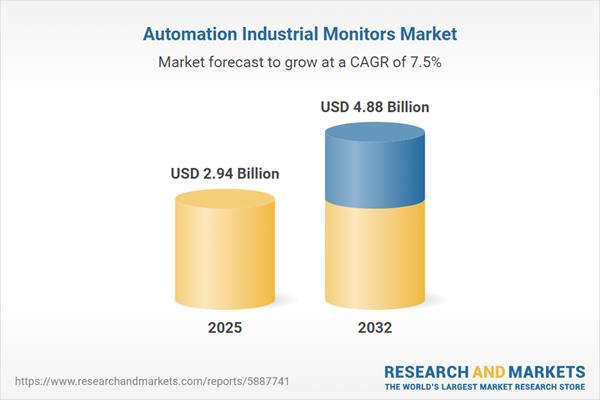Speak directly to the analyst to clarify any post sales queries you may have.
The automation industrial monitors market is at the forefront of empowering digital transformation across global manufacturing and processing sectors. These solutions offer the critical foundation for operational visibility and robust decision-making, enabling senior leaders to align enterprise strategies with advanced technology adoption and regulatory compliance.
Market Snapshot: Automation Industrial Monitors Market Trends and Growth
The Automation Industrial Monitors Market grew from USD 2.74 billion in 2024 to USD 2.94 billion in 2025. It is expected to continue growing at a CAGR of 7.46%, reaching USD 4.88 billion by 2032.
Scope & Segmentation: Comprehensive Market Coverage
- Industry Vertical: Automotive (Aftermarket, OEM); Energy & Utilities (Power Generation, Transmission & Distribution, Water Utilities); Healthcare & Pharmaceuticals (Hospitals, Pharmaceutical Manufacturing); Manufacturing (Automotive, Consumer Goods, Electronics, Food & Beverage); Oil & Gas (Exploration & Production, Refining).
- Monitor Type: Condition monitoring (Oil Analysis Sensors, Thermal Imaging, Ultrasound Monitors, Vibration Monitors); Energy management (Energy Meters, Load Controllers, Power Quality Analyzers); Environmental monitoring (Air Quality, Emissions, Noise Monitors); Process automation (Flow, Humidity, Level, Pressure, Temperature Monitors); Safety monitoring (Emergency Stop Systems, Fire & Smoke Detectors, Gas Leak Detectors).
- End Use Application: Predictive maintenance (Oil Condition, Thermal, Vibration Analysis); Quality control (Process Analytics, Vision Systems); Real-time monitoring (PLC, SCADA Integration); Safety & Compliance (Alarm Management, Regulatory Reporting).
- Connectivity Technology: Cloud-enabled (Hybrid, Private, Public Cloud); Wired (Ethernet, Fieldbus, Modbus); Wireless (Bluetooth, LPWAN, WiFi).
- Sales Channel: Direct sales (Manufacturer Sales Force, OEM Partnerships); Distributor (System Integrators, Value Added Resellers); Online (E-Commerce Platforms, Manufacturer Portals).
- Regional Coverage: Americas (North America: United States, Canada, Mexico; Latin America: Brazil, Argentina, Chile, Colombia, Peru); Europe, Middle East & Africa (EMEA: United Kingdom, Germany, France, Russia, Italy, Spain, Netherlands, Sweden, Poland, Switzerland, UAE, Saudi Arabia, Qatar, Turkey, Israel, South Africa, Nigeria, Egypt, Kenya); Asia-Pacific (China, India, Japan, Australia, South Korea, Indonesia, Thailand, Malaysia, Singapore, Taiwan).
- Key Companies: Siemens AG, Rockwell Automation, ABB Ltd, Schneider Electric, Emerson Electric, Honeywell International, Mitsubishi Electric, Omron Corporation, Yokogawa Electric, Keyence Corporation.
Key Takeaways for Senior Decision-Makers
- Automation industrial monitors are integral to enabling operational efficiency, safety enhancements, and the adoption of predictive maintenance strategies in Industry 4.0 environments.
- Edge computing and artificial intelligence are transforming monitoring processes by delivering immediate insights and supporting resilient plant operations, even with variable connectivity.
- Regulatory demands and environmental compliance increasingly drive organizations to implement advanced monitoring systems across emissions, air quality, and noise measurements.
- Regional growth patterns are influenced by local infrastructure maturity and regulatory requirements, necessitating localized solutions and tailored service offerings for global businesses.
- Technology providers are expanding their portfolios through modular architectures, managed monitoring services, and regional service centers to strengthen customer support and competitive positioning.
Tariff Impact: Navigating Shifting Trade Policies
With new United States tariffs affecting sensor and monitor sourcing from 2025, production costs and supply chain timelines are impacted. Manufacturers and end users are actively reassessing sourcing strategies, including local manufacturing, dual-sourcing, and nearshoring, to minimize tariff exposure and maintain progress in digital transformation projects. Flexible procurement models and inventory strategies are emerging as essential responses to manage ongoing policy uncertainty and cost fluctuations.
Methodology & Data Sources
This report's analysis is built on primary research via interviews with industry leaders and managers, combined with secondary research from technical literature, regulatory reports, and case studies. Data triangulation and quality checks ensure accurate, reliable findings for strategic planning.
Why This Report Matters
- Enables executive teams to benchmark current monitoring capabilities and align technology investments with regulatory shifts and sustainability targets.
- Provides actionable insights for optimizing supply chain decisions in the context of evolving tariff regimes and regional market complexities.
- Empowers decision-makers to develop agile implementation strategies that leverage workforce development, new technologies, and cross-functional collaboration.
Conclusion
Advanced automation monitoring solutions will continue evolving in their capacity to enhance operational resilience, sustainability, and strategic agility. Leaders adopting proactive, collaborative approaches are best positioned to capture the full value of industrial monitors in a rapidly advancing market.
Additional Product Information:
- Purchase of this report includes 1 year online access with quarterly updates.
- This report can be updated on request. Please contact our Customer Experience team using the Ask a Question widget on our website.
Table of Contents
3. Executive Summary
4. Market Overview
7. Cumulative Impact of Artificial Intelligence 2025
Companies Mentioned
The companies profiled in this Automation Industrial Monitors market report include:- Siemens Aktiengesellschaft
- Rockwell Automation, Inc.
- ABB Ltd
- Schneider Electric SE
- Emerson Electric Co.
- Honeywell International Inc.
- Mitsubishi Electric Corporation
- Omron Corporation
- Yokogawa Electric Corporation
- Keyence Corporation
Table Information
| Report Attribute | Details |
|---|---|
| No. of Pages | 180 |
| Published | October 2025 |
| Forecast Period | 2025 - 2032 |
| Estimated Market Value ( USD | $ 2.94 Billion |
| Forecasted Market Value ( USD | $ 4.88 Billion |
| Compound Annual Growth Rate | 7.4% |
| Regions Covered | Global |
| No. of Companies Mentioned | 11 |









